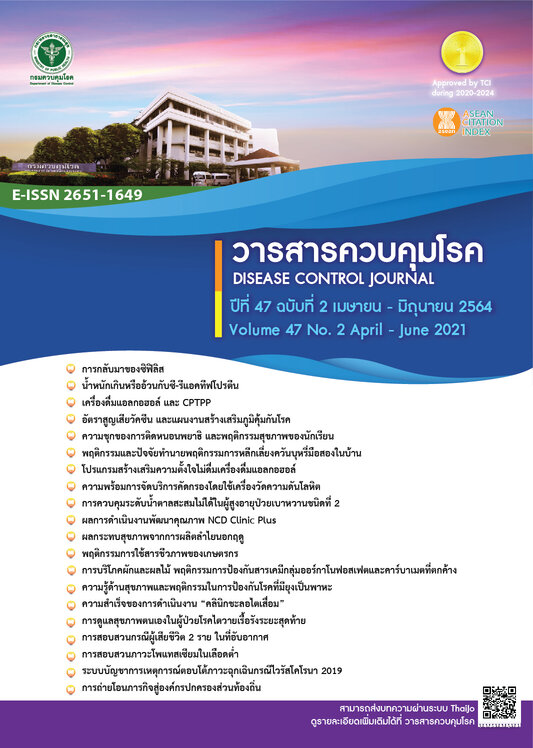An outbreak investigation of hypokalemia among inmates at a prison in Chiang Mai province, During February - June 2019
DOI:
https://doi.org/10.14456/dcj.2021.35Keywords:
investigation, hypokalemia, prison, Chiang MaiAbstract
The aims of this study were to confirm the diagnosis and outbreak, describe epidemiology of the outbreak, and implement control measures for hypokalemia among inmates at one prison in Chiang Mai Province. The study was conducted during May-June 2019 which included descriptive study, matched case-control study, environmental study, and laboratory study. Among 1358 inmates, there were 145 patients by case definition. The attack rates were 11.92% in males and 3.83% in females. The age ranged between 18 - 75 years old, with an average age of 39 years old. Most of them had weakness in limbs and fatigue. The study showed a possible continuous common source. The matched case-control study showed that hypokalemia was not significantly associated with hyperthyroid, hypomagnesaemia, renal potassium loss, number of meals per day, consumption of meat, vegetables and fruits. Of the 28 persons examined for serum potassium, 14 (50%) had hypokalemia (less than 3.5 mEq/L). One of the 4 pork samples examined on 1 June 2019 was found to contain thyroid grand and all the 8 pork samples examined for thyroid hormone had abnormally high levels. The cause of hypokalemia among prisoners in this event might be due to hyperthyroid condition from eating pork contaminated with thyroid hormone.
Downloads
References
Gennari FJ. Hypokalaemia. New Eng J Med. 1998;339:451-8.
Liamis G, Rodenburg EM, Hofman A, Zietse R, Stricker BH, Hoorn EJ. Electrolyte disorders in community subjects: prevalence and risk factors. Am J Med. 2013;126(3):256-63.
Dipiro JT, Talbert RL, Yee GC, Matzke GR, Wells BG, Posey LM, editors. Pharmacotherapy: A patho physiologic approach, 9th ed. New York: McGraw-Hill. 2014:783-96.
Kim GH, Han JS. Therapeutic approach to hypokalemia. Nephron. 2002;92(Suppl1):28-32.
Marti G, Schwarz C, Leichtle AB, Fiedler GM, Arampatzis S, Exadaklylos AK, et al. Etiology and symptoms of severe hypokalemia in emergency department patients. European Journal of Emergency Medicine. 2014;21(1):46-51.
Viera AJ, Wouk N. Potassium disorders: hypokalemia and hyperkalemia. Am Fam Physician. 2015;92(6):487-95.
Kraft MD, Btaiche IF, Sacks GS, Kudsk KA. Treatment of electrolyte disorders in adult patients in the intensive care unit. Am J Health Syst Pharm. 2005;62:1663-82.
Konrad M, Schlingmann KP, Gudermann T. Insights into the molecular nature of magnesium homeostasis. Am J Physiol Renal Physiol. 2004;286:F599-605.
Hongjan P, Pingkan P, Leasoben N, Chotichusri A. Prajong P, Keadsalung K. Outbreak verification summary. Weekly Epidemiological Surveillance Report. 2019;52:773-5. (in Thai)
Department of Corrections (TH). Announcement: case study on hyperthyroid epidemic in prison [Internet]. Nonthaburi: Department of Corrections (TH); 2017. (in Thai)
Downloads
Published
How to Cite
Issue
Section
License
Articles published in the Disease Control Journal are considered as academic work, research or analysis of the personal opinion of the authors, not the opinion of the Thailand Department of Disease Control or editorial team. The authors must be responsible for their articles.






